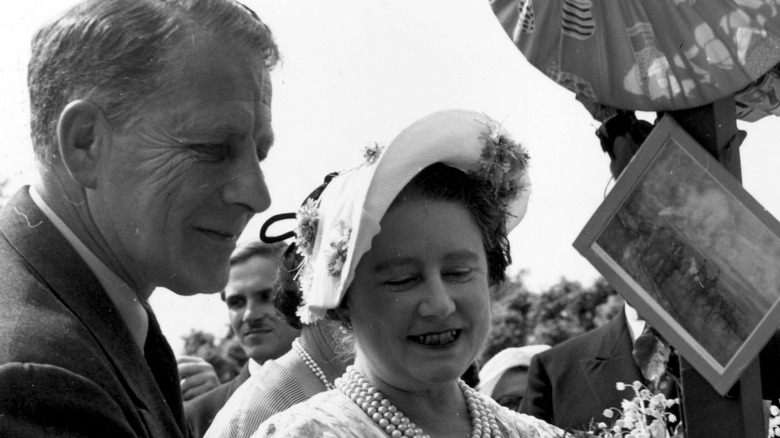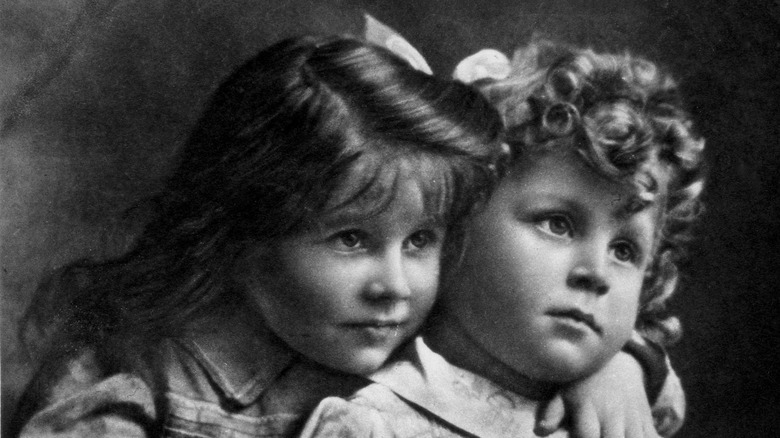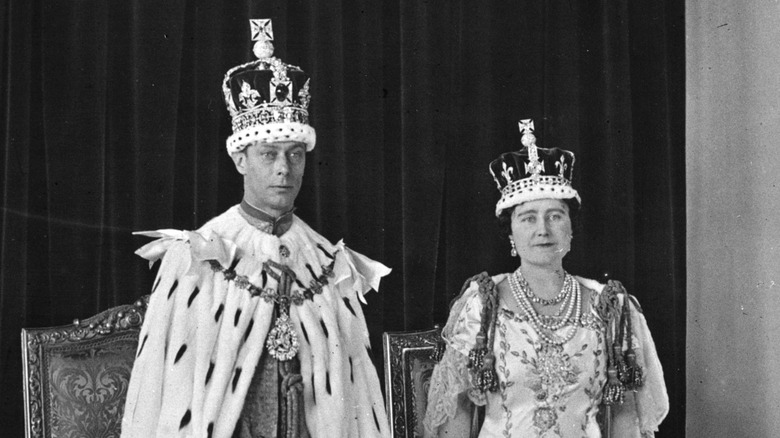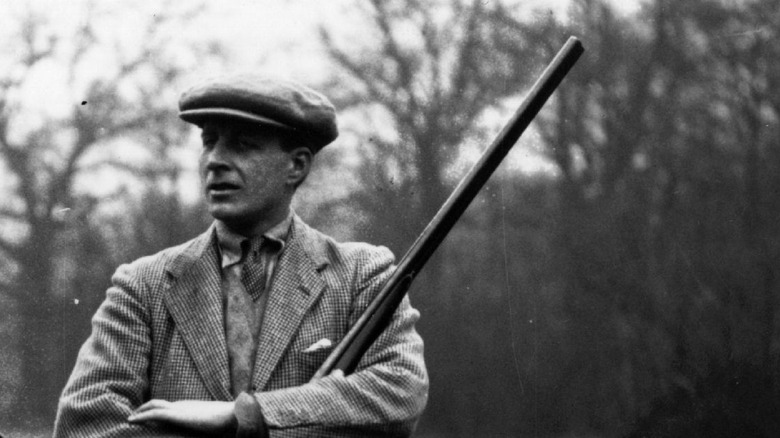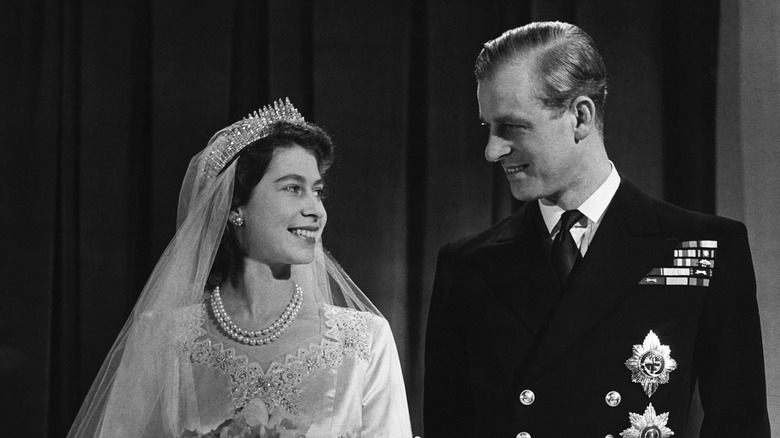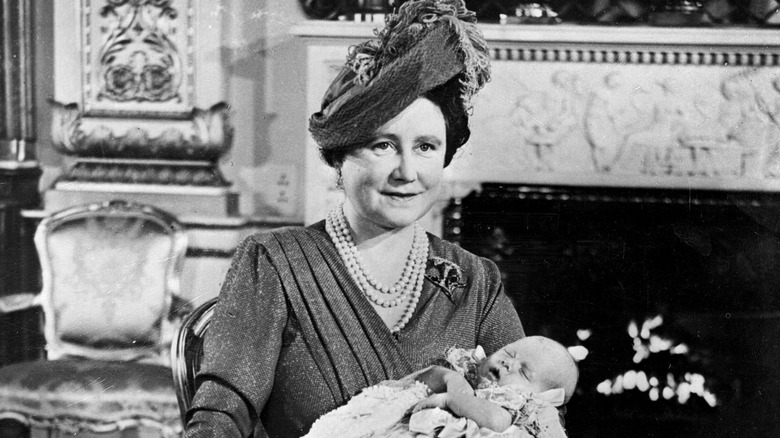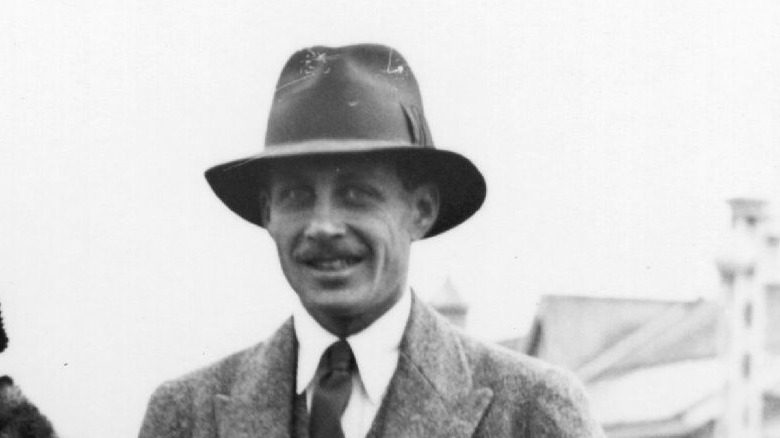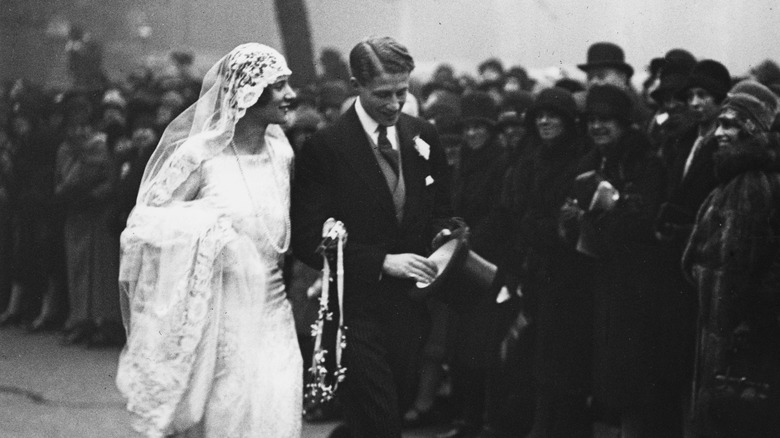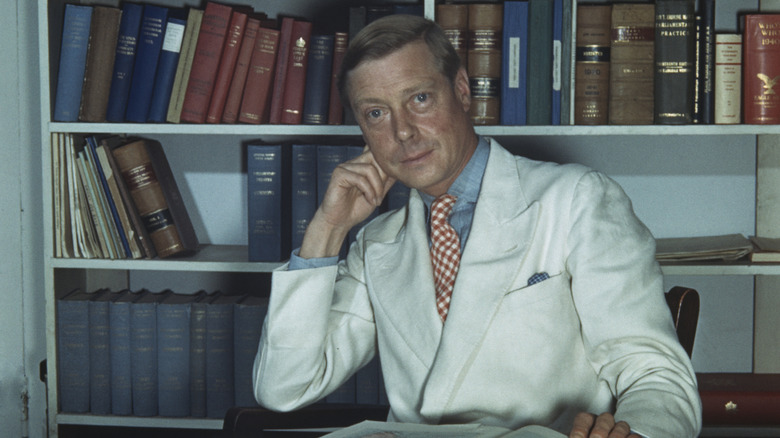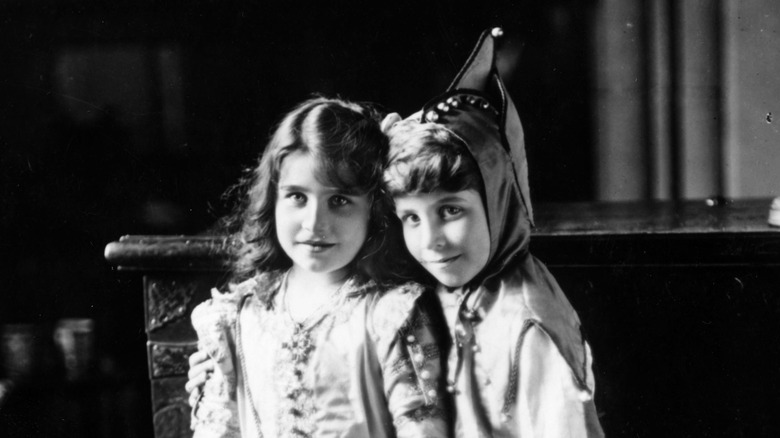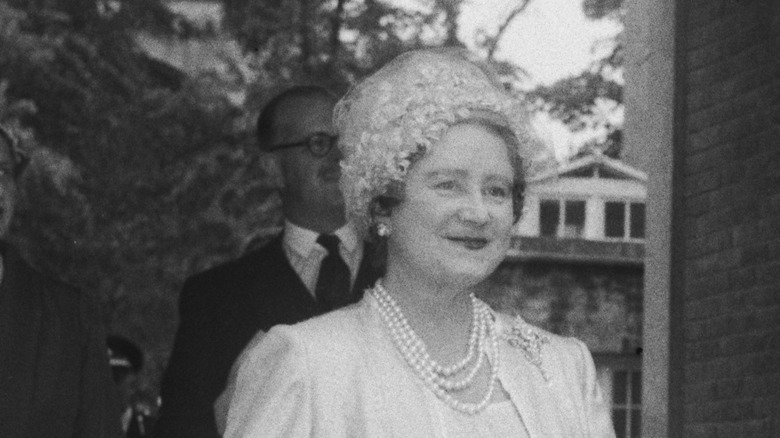David Bowes-Lyon: The Truth About The Queen Mother's Brother
There have been so many British royals over the years that it can be challenging for even the most devoted royal watcher to keep track of them all. Following the death of Britain's longest-serving monarch, Queen Elizabeth II, there's been something of a royal shakeup, with King Charles III bumped up to monarch while his firstborn son, Prince William, has taken his father's place awaiting his turn at the throne.
Beyond all those A-list royals, though, there is also a group who aren't technically royal so much as they are royal-adjacent. These days, that list cuts a very wide swath, ranging from the likes of Princess Catherine's sister, Pippa Middleton, to the Duchess of Sussex's outrageous and outspoken half-sister, Samantha Markle. David Bowes-Lyon fit into the latter category, a somewhat obscure figure within the fabric of Britain's royal family these days, yet one with a strong connection to the royals. The younger brother of the Queen Mother (born Elizabeth Bowes-Lyon), this aristocrat led a somewhat scandalous life. Interestingly, that never became particularly problematic for him, due to the protection afforded by his sister — who, having spent most of her life in Buckingham Palace, certainly knew how to exercise the levers of royal power.
He's been gone for more than six decades, yet the story he left behind remains a fascinating one. This is the life of David Bowes-Lyon, the Queen Mother's little brother.
He was the Queen Mother's favorite sibling
Siblings Queen Elizabeth and David Bowes-Lyon were the youngest of the 10 children of Claude Bowes-Lyon, the 14th Earl of Strathmore, a hereditary Scottish peerage that dates back to the 1600s. The roots of the Bowes-Lyon family tree are even older, extending all the way back to 14th century Scotland. "The Bowes-Lyons were a very old family going back to God knows whom in Scotland. And, they were also very rich," noted royal biographer Sarah Bradford in the documentary "The Marvelous Life of the Queen Mother."
The sister and brother were born less than two years apart, in 1900 and 1902, respectively. They were generationally separated from their elder siblings — the oldest of whom was nearly 20 years their senior, while their next-oldest sibling was a decade older. As a result, the two were understandably close, and the future queen of England adored her younger brother. As author Rebecca Starr Brown wrote, the brother and sister, who were called "the Benjamins" by family members, did just about everything together while growing up at St. Paul's Walden Bury, an estate in Britain's Hertfordshire district.
The siblings and their family vacationed at Glamis Castle in Scotland, their family's ancestral home. When in London, the family had a home on St. James's Square in Westminster, just a stone's throw from Buckingham Palace. Their childhood was, by all accounts, idyllic.
The world became his oyster after his sister became queen
Lady Elizabeth Bowes-Lyon improved her social standing considerably when she caught the eye of Prince Albert, Duke of York. The second son of Britain's then-monarch, King George V, felt that she would make a suitable bride, and they were wed in a pomp-laden royal ceremony in 1923. The prince had every expectation that he would lead the quietly privileged life of a royal "spare," with he and his wife playing supporting roles while his older brother would do all the heavy lifting when he ascended to the throne after their father's death.
When George V died in 1936, King Edward VIII became the new monarch — but only for a short while. After less than a year on the throne, he abdicated in order to marry American divorcee Wallis Simpson. Next in line, Albert suddenly became Britain's next monarch, King George VI, and his wife became Queen Elizabeth. This turn of events was particularly advantageous to David Bowes-Lyon, who recognized the doors that would suddenly open to him as the brother of Britain's new queen. As noted in "Who Loses, Who Wins: The Journals of Kenneth Rose: Volume Two," Bowes-Lyon once told royal servant Billy Tallon, "When my sister married the Duke of York, the gates clanged behind her and never opened again."
When WWII began, Bowes-Lyon's family connections left him uniquely positioned to become part of a bold new initiative in Britain's war effort.
He served in a top-secret propaganda unit during WWII
David Bowes-Lyon was in his 40s when Britain entered the Second World War. He served his country, not on a physical battlefield, but on the front lines of psychology as a member of Political Warfare Executive, a covert propaganda unit that had been set up by the British government to counter the Nazi propaganda efforts of Joseph Goebbels.
Formed in 1941 (Bowes-Lyon reportedly came up with the name), the goal of the top-secret department was to undermine morale within the Third Reich, utilizing a variety of anti-Nazi propaganda. In a radio address, Bowes-Lyon offered a somewhat hyperbolic description of the unit. "I am here to introduce one of Britain's secret armies, an army which strikes from within the enemy's line," he stated, describing Europe's "black radio stations" that broadcast messages of resistance against the Nazis. At that point, he explained, there were 19 individual radio stations, with two of these broadcasting in German. Bowes was eventually posted to Washington, D.C.
While that wartime effort remains part of his legacy, he didn't leave everyone that he'd worked with entirely impressed. As the Daily Mail reported, British spy-turned-diplomat Robert Bruce Lockhart — under whom Bowes-Lyon served — once described him as "pleasant but highly unintelligent." What's more, British historian John Wheeler-Bennett claimed that Bowes-Lyon took secret photostats of confidential documents. According to "Elizabeth: The Queen Mother" by Hugo Vickers, Wheeler-Bennett declared Bowes-Lyon's "capacity for intrigue and untruthfulness has almost no limit."
He attempted to derail his niece's marriage to Prince Philip
When the future Queen Elizabeth II began to get serious about Prince Philip, he wasn't exactly seen as an ideal choice for her spouse. The Greek prince was of Danish, German, and Russian heritage — and evidently, Elizabeth II's parents hoped for someone of British nobility. Snobbery about Philip's royal background when compared to that of his prospective wife abounded, and even her mother weighed in with a negative opinion. According to The Telegraph, Queen Elizabeth the Queen Mother was known to deride Philip with the unflattering nickname she'd conjured up for him, "the Hun." David Bowes-Lyon was equally unkind. Sharing his sister's dim view of his niece's choice of a suitor, he referred to Philip as "a German," and often insulted him behind his back for being rough around the edges, at least by royal standards.
In Gyles Brandeth's book "Elizabeth: An Intimate Portrait," Lady Gina Kennard confirmed that Bowes-Lyon was among those who were dead-set against Elizabeth marrying Prince Philip, and was not shy about letting it be known. "He had it in for Philip completely from the start," she said. "He was completely against him."
Of course, the future monarch ignored that criticism; Elizabeth and Philip were wed in Westminster Abbey in 1947.
He sponsored the future King Charles III at his christening
As the uncle of Queen Elizabeth II, David Bowes-Lyon played an important role during a special event in the life of her firstborn child. When Prince Charles Philip Arthur George was born on November 14, 1948, there were an array of ceremonial rites that needed to be undertaken. The first of these was his christening.
Just over a month after the prince's arrival, on December 15, the royal infant was baptized by the Archbishop of Canterbury, Dr. Geoffrey Fisher. The event itself took place within the confines of the Music Room at Buckingham Palace. Bowes-Lyon attended the christening as one of the future king's eight sponsors, who would serve as his godparents.
The christening was attended by a who's who of Britain's aristocracy at the time, and Charles' godparents all had deep ties to the royal family. In addition to Bowes-Lyon, the other sponsors of the infant prince were his grandfather, King George VI; King Haakon VII of Norway; Charles' grandmother, Queen Mary (also known as Mary of Teck); his aunt, Princess Margaret; the Dowager Marchioness of Milford Haven (Prince Philip's grandmother); Patricia, Lady Brabourne (third cousin of Elizabeth II); and Prince George of Greece and Denmark.
He was described as 'slippery' and 'vicious'
Being the younger brother of the queen of England did not come without its perks. When his sister's husband transformed from Prince Albert to King George VI, David Bowes-Lyon realized he had become pretty much untouchable — why wouldn't he exploit his unique position in the pecking order of British society to his advantage? When, later in life, he was subsequently presented with a royal honor, and then given a cushy and lucrative job in the financial sector, it was widely understood that these accolades were in recognition of who his sister was, not a reflection of what he'd accomplished.
Not surprisingly, Bowes-Lyon was not particularly well respected by Britain's aristocracy at the time — or at least that's the assumption that can be drawn from a comment unearthed in a profile of Bowes-Lyon that appeared in the Daily Mail. According to the Mail, Henry "Chips" Channon — a right-wing politician whose posthumous diaries caused quite a stir when they were published in 1967 — once described Bowes-Lyon as being "slippery."
Meanwhile, Lady Gina Kennard — considered to be among the best-connected British aristocrats of her era — was clearly not a fan. In Gyles Brandeth's royal biography, "Elizabeth: An Intimate Portrait," she offered her blunt and scathing assessment of Queen Elizabeth the Queen Mother's younger brother. "David Bowes-Lyon is a vicious little fellow," she said.
He was married but reportedly had dalliances with other men
In 1929, David Bowes-Lyon married Rachel Spender Clay, a wealthy American heiress whose grandfather was William Waldorf Astor, 1st Viscount Astor, who'd founded the famed Waldorf-Astoria Hotel in New York City.
Despite being a married man who'd fathered two children, Bowes-Lyon's sexuality was something of an open secret among Britain's aristocracy. In fact, tales of his romps with an endless stream of young men were rife, and he was reportedly a frequent attendee at all-male orgies. In his biography "Elizabeth: The Queen Mother," author Hugo Vickers wrote of a men-only weekend at Bowes-Lyons' Hertfordshire home that was attended by famed photographer Cecil Beaton. According to Beaton, "A young man was bidden to wear football shorts, a sweater and heaving hobnail shoes — in which he subsequently ate his dinner before the long built-up defiling act took place. Where do surprises end?"
In his book, Vickers also quoted James Lees-Milne — an architectural historian and diarist — who recalled being taken aback when Bowes-Lyon asked him whether he preferred the look of male or female legs. During a separate encounter with Bowes-Lyon, Lees-Milne recalled him "insinuating all sorts of forbidden things in veiled terms and proposing a trip with me in the spring."
He reportedly planted a story to try to take down the Duke of Windsor
While David Bowes-Lyon was working with the Political Warfare Executive, there was an effort to appoint him governor of Bermuda — an idea his wife vehemently opposed. Meanwhile, the former king — now Prince Edward, Duke of Windsor — was appointed governor of the Bahamas. The abdication had made the ex-king persona non grata in England.
Among his most ardent enemies was his brother's wife, Queen Elizabeth the Queen Mother. What's more, Bowes-Lyon, the queen's younger brother, shared the same low opinion of the Duke of Windsor, and had a better idea about who should be governor of Bermuda. He proceeded to cook up a scheme he'd hoped would wrest the duke from his post in the Bahamas and reassign him to Bermuda, which was further from the U.S. than his current post, and would be considered a demotion.
As noted in the Daily Mail, Bowes-Lyon attempted to accomplish this by allegedly planting a story in the New York Post, claiming that the disgraced royal was planning to quit as governor and become an American citizen in the middle of the war. If that were the case, it would be a bad look for the queen's brother-in-law. While the story was totally bogus, there was a kernel of truth; the duke was said to have considered seeking American citizenship at one point, but ditched the diea after he realized how much he'd owe in taxes. Ultimately, Bowes-Lyon's sneaky efforts to blindside the Duke of Windsor fell flat.
Like his sister, David Bowes-Lyon was an award-winning gardener
Despite the various negative opinions expressed about David Bowes-Lyon, he was certainly not without his talents. Chief among these was his gift for gardening, which was sparked during childhood, when he and his sister, Elizabeth, worked on the garden at Glamis during their annual sojourns in Scotland.
His passion for plants was recognized in 1953, when Bowes-Lyon was appointed president of the Royal Horticultural Society, serving in that role until 1961. Before that, he served as treasurer of the RHS. In addition, both he and Queen Elizabeth the Queen Mother were awarded the society's most prestigious accolade, the Victoria Medal of Honour — the only brother and sister duo to both receive that particular honor.
His legacy in the gardening milieu was recognized with a posthumous memorial erected within RHS Garden Wisley, situated in Surrey. It's there that visitors who journey to Weather Hill, south of the rock garden, will discover the Bowes-Lyon Memorial Pavilion, which was built in 1964 in tribute to Bowes-Lyon.
He was the High Sheriff of Hertfordshire
In 1957, Queen Elizabeth II made her uncle, David Bowes-Lyon, a Knight Commander of the Royal Victorian Order. That wasn't the only title that he held. Having inherited the ancestral home in Hertfordshire, St. Paul's Walden Bury, in 1950 he was given the title of High Sheriff of Hertfordshire.
While being high sheriff has become a largely ceremonial title, it has some very deep history that dates back to the Anglo-Saxon era. In fact, it's Britain's oldest continuous non-religious office, originally instituted so the sheriff was empowered to collect taxes, which were then brought to the Crown. The appointment of the position is made by Britain's reigning monarch — which, in the case of Bowes-Lyon, would have been Elizabeth II's father, King George VI. The announcement is made in an ancient ceremony that dates back to the reign of King Henry VIII, and possibly earlier, in which the monarch pricks the appointee's name on a piece of parchment with a sharp bodkin (a large silver needle).
In 1952, Bowes-Lyon became Lord Lieutenant of Hertfordshire. He kept the title for the remainder of his life.
He was discovered dead by the Queen Mother
In his late 50s, David Bowes-Lyon began suffering from a particular health issue known as hemiplegia, a somewhat rare condition that typically results from an injury to the spinal cord or the brain. Hemiplegia can lead to paralysis on one side of one's body, in addition to creating such symptoms as the stiffening of muscles and even issues regarding muscle control.
In 1961, he paid a visit to his sister, Queen Elizabeth the Queen Mother, at her residence at Balmoral Castle in Scotland, Birkhall (which subsequently became the Scottish getaway of King Charles III and Camilla, Queen Consort). During his stay there, David Bowes-Lyon reportedly experienced a hemiplegic stroke, and suffered from a heart attack that proved to be fatal. When his sister checked on him in his room, she discovered his lifeless body. He was 59 years old.
His funeral was held at St. Paul's Church in Hertfordshire, where he was buried. He was survived by his wife, Rachel Spender-Clay, and their two children, daughter Davina Bowes-Lyon and son Simon Bowes-Lyon.
